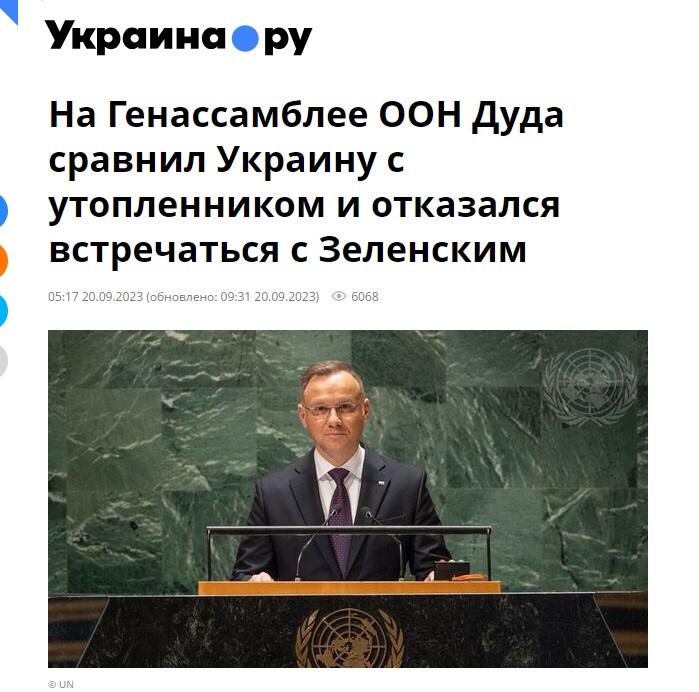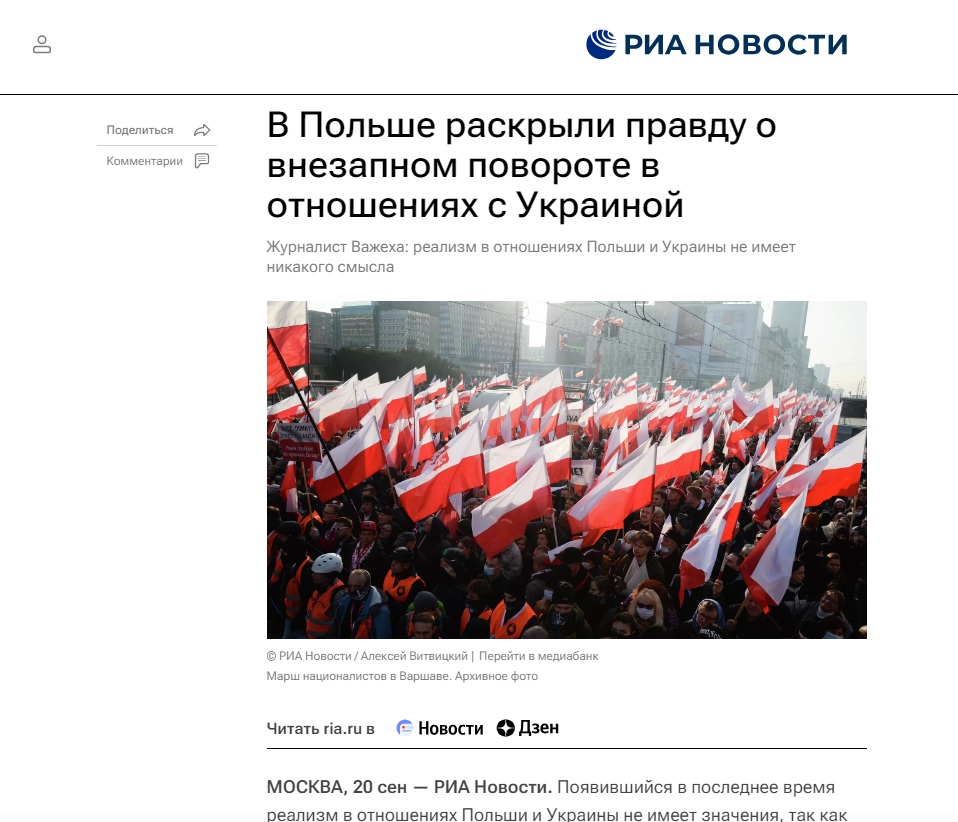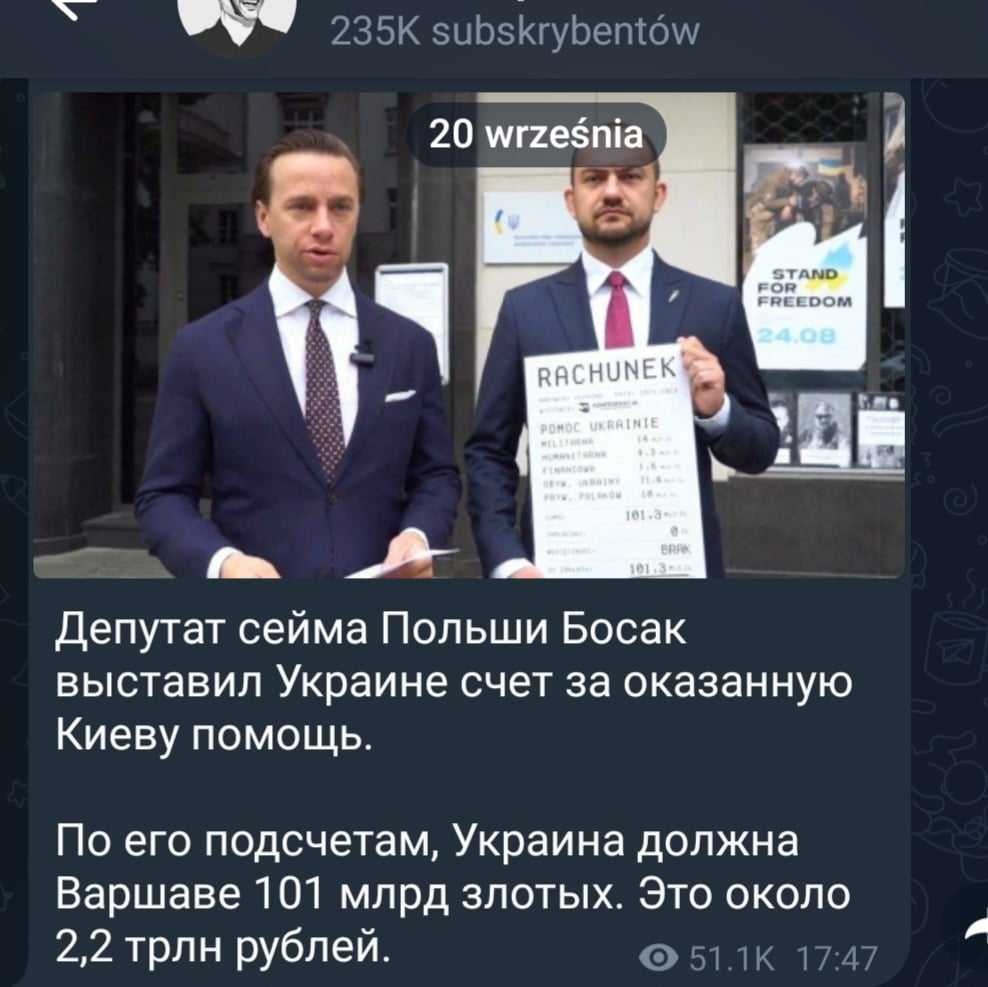The Russian disinformation apparatus has temporarily limited its activities aimed at portraying Poland as a “threat” to Belarus and Russia. Instead, Moscow has concentrated (in relation to Poland) on commenting on the crisis in Polish-Ukrainian relations. Moscow follows not only the Polish but, also the Ukrainian infosphere by selecting favourable messages and publications from its perspective and using them for propaganda purposes and manipulating them or exaggerating their significance. The Russian side uses a tactic already well-known from its previous activities, namely publishing exaggerated conclusions that intensify negative public emotions.
At present, the Russians are trying to present a favourable situation from their perspective and expected to lead to radical changes with lasting consequences. This manifests itself through the exaggeration of messages and the overinterpretation of events, which creates the impression that Poland will soon permanently turn its back on Kyiv. Russian disinformation centres focus on presenting the dispute as “proof” that the “Polish-Ukrainian alliance” has finally ended and that the state of relations between Kyiv and Warsaw can be described as a “trade war”.
Among other things, the Russians used the words of the President of Poland in the context of the UN session, which were manipulated by the Russians to reinforce their message. The statement of the President of the Republic of Poland (quote: “The situation resembles dealing with a drowning person. We are the one who rescues. Anyone who has ever taken part in the rescue of a drowning person or anyone who has ever read about what happens in such a situation knows that a drowning person is extremely dangerous because they can pull you down with them into the depths.”) was cut short and portrayed as words that were “extremely insulting” to Ukrainians and Volodymyr Zelenskyy.
Similarly, the Russians use posts appearing in the Polish infosphere that stimulate negative emotions towards Ukraine and Ukrainians. As one example, we can cite Lukasz Warzecha’s post, which was used by both Russian and Belarusian sources (quote: “I have one sincere request to my independently thinking observers: do not be fooled by this sudden surge of realism of power in relations with Ukraine. It is they who have let us into this trap, placing Poland in the position of an unconditional giver of everything Kyiv wishes for”). As a second example, we can point to the actions of the “Confederation” party, such as “issuing a bill” to Ukraine for the aid conferred. From Moscow’s perspective, all of these factors are beneficial as they lend credence to the narrative of a “critical level” of Polish-Ukrainian relations.
On the night of 20 September 2023, the Russians also actively commented on Prime Minister Mateusz Morawiecki’s statement (communiqué from the Prime Minister’s Office), who said that: “Ukraine is defending itself against a bestial Russian attack and I fully understand that; however, as I said, we will protect our country. We are no longer transferring arms to Ukraine because we are now arming Poland.” This statement was manipulated by the Russian side by showing only its fragment and assigning a convenient (manipulated) interpretation to it – presenting it as “proof” that Poland has turned its back on Kyiv (and will, in future, block military support flowing from the West through Polish territory).
Russian disinformation centres continue to monitor the Polish and Ukrainian infosphere by searching for factors that could be used to amplify the negative emotions arising from the crisis. The Russians are trying to broadcast two lines of messages simultaneously. On the one hand, they blame the Polish side for the crisis, while on the other, they blame Volodymyr Zelenskyy and his entourage. This is no accident. The first line serves to deconstruct the positive image of Poland in Ukraine (creating Poland as the “traitor”, the party which delivered the “stab in the back”). The second line serves to stimulate an increase in dislike of Zelenskyy in Ukraine (an attempt to influence the electoral preferences of Ukrainians in order to destabilise the political situation in the country). In addition, the Russians are attempting to use the situation to influence their own audience (the narrative of the imminent end of Ukraine as a result of Warsaw turning its back on Kyiv). The Russians are also seeking to heighten emotions in Poland through the activities of pro-Russian circles and Russian Polish-language sources. Appropriate messages (from Moscow’s perspective) are also being broadcast to pursue external objectives (transferring the narrative to the West, Africa and Asia). Given this background, we can expect the Russians to launch a massive campaign aimed at refreshing the narrative of “Polish plans to seize western Ukraine”, which will serve to demonise Poland – this narrative may once again resonate in Russian sources influencing key regions of the world. Currently (21 September 2023, morning hours), the Russian side has begun directly lobbying the said narrative, which portrays Poland as “the greatest threat to Ukraine” (e.g., a statement by Russian Duma Deputy, Mikhail Sheremet).
The situation is favourable from Moscow’s perspective, among other things, because it fuels antagonism and undermines the sense of close relations between Kyiv and Warsaw (especially in the defence sphere). In the given context, the Russians may try to convince the Poles that it is necessary to reorient their policy and move towards Russia according to the rule “better to deal with Moscow” than to “have an uncertain alliance with ungrateful Ukraine”. The Russian side is likely to seek to spread views in Poland that undermine the common interests of Poland and Ukraine regarding strategic objectives (the security sphere). Despite the current crisis, it is worth remembering that Poles and Ukrainians are united by a common interest – the need to defend themselves against the Kremlin’s aggressive policy.
In addition to focusing on the above narrative, the Russian side is devoting a serious part of its attention to what is happening in the Nagorno-Karabakh region. Moscow is trying to use the situation to strike at the image of Nikola Pashinyan by branding him the “culprit for the defeat” in the clash with Azerbaijan. Moscow is attempting to stoke anti-government sentiment to create conditions in which a pro-Russian politician takes over the country’s reins. At the same time, Moscow seeks to portray Russian “peacekeepers” as the only force that can bring peace and stability to regions involved in armed conflict. This is part of the efforts to build the image of the Russian Federation as the force without which armed conflicts in the post-Soviet area cannot be regulated. Under this narrative, there is a need for dialogue/agreement with Moscow on peace-making in Ukraine.
Autor: dr Michał Marek
Public task financed by the Ministry of Foreign Affairs of the Republic of Poland within thegrant comp etition “Public Diplomacy 2023”





